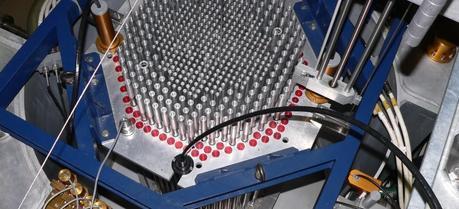 CROCUS is a research reactor at École Polytechnique Fédérale de Lausanne in Switzerland, sometimes described as zero power but in fact limited to 100 W. Small reactors are defined by the International Atomic Energy Agency as those with an electricity output of less than 300 MWe. (Credit: Rama http://commons.wikimedia.org/wiki/User:Rama)
CROCUS is a research reactor at École Polytechnique Fédérale de Lausanne in Switzerland, sometimes described as zero power but in fact limited to 100 W. Small reactors are defined by the International Atomic Energy Agency as those with an electricity output of less than 300 MWe. (Credit: Rama http://commons.wikimedia.org/wiki/User:Rama)A detailed assessment of a new type of nuclear reactor, termed the Small Modular Reactor (SMR), has been published to help policymakers decide on the best way to meet the growing demand for energy.
According to several different estimates world energy consumption in 2035 will be more than double that of 1995. (See the International Energy Agency’s World Energy Outlook 2013, the Energy Perspectives report by Statoil, a study by Siemens or the EIA projections.) A substantial challenge for engineers and scientists over the coming decades is to develop and deploy power plants with sufficient capacity and flexibility to meet this increasing need while simultaneously reducing emissions.
The new research paper, published in the academic journal Progress in Nuclear Energy (see footnote), aims to show to what extent small modular reactors might provide a solution to fulfill these energy needs.
Modern small modular reactors are a relatively new product in the nuclear industry, being of a smaller size making it easier to implement new technical solutions and for construction purposes.
Lead author Dr Giorgio Locatelli, from the School of Engineering, University of Lincoln, UK, provides a state-of-the-art appraisal of SMRs, particularly focusing on the Light Water Reactor (LWR), detailing the economic and social limitations for their viable deployment.
Dr Locatelli said: “With fusion-based power plants not currently being considered viable for large-scale deployment for at least 40 years, other technologies must to be considered. Renewable and high efficiency combined gas-fired plants, along with nuclear power plants, are regarded as the most suitable candidates, with small modular reactors (SMRs) developing as a favored choice.”
“Given the extreme relevance and complexity of the field, this paper aimed to bring together the contributions of scholars and practitioners with state-of-the-art papers and reports.”
One of the main issues surrounding nuclear power is safety, particularly following the Fukushima accident.
The simplification, standardization and compactness of SMRs allows for certain improvements on reactor safety and physical protection, although these are design specific. These improvements are primarily due to SMRs being “passive systems” that dramatically reduce the effects of human error and perform well and predictably in extreme circumstances.
Their small size makes them a good option for locations that cannot accommodate large-scale plants and they also require limited upfront capital investment.
Dr Locatelli concludes that SMRs are a suitable choice when the power to be installed is in the range of 1-3 Gigawatt Electrical (GWe).
This range is mainly for newcomers to the nuclear market (such as Kenya) or private utilities (such as in the US). Large Reactors (LRs) are still preferable for markets requiring several GWe.
He said: “Considering non-financial factors, preliminary results indicate that SMRs perform better or at least as well as Large Reactors (LRs). However, the “not in my back yard” syndrome limits the possibility of using SMRs on many sites. The social aspects of SMRs, such as the creation of new jobs, is also positive and a goal of policymakers.
“We expect that SMRs will play an important role in nuclear industry in the next decades.”
Locatelli, G., Bingham, C., & Mancini, M. (2014). Small modular reactors: A comprehensive overview of their economics and strategic aspects Progress in Nuclear Energy, 73, 75-85 DOI: 10.1016/j.pnucene.2014.01.010
